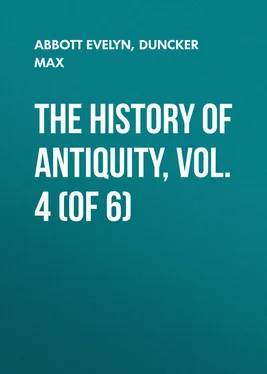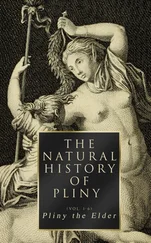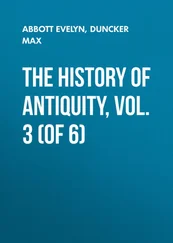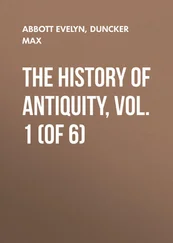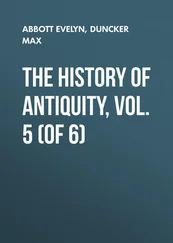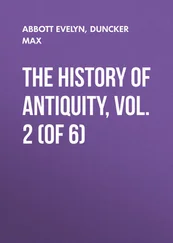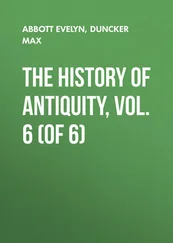Max Duncker - The History of Antiquity, Vol. 4 (of 6)
Здесь есть возможность читать онлайн «Max Duncker - The History of Antiquity, Vol. 4 (of 6)» — ознакомительный отрывок электронной книги совершенно бесплатно, а после прочтения отрывка купить полную версию. В некоторых случаях можно слушать аудио, скачать через торрент в формате fb2 и присутствует краткое содержание. Жанр: foreign_antique, foreign_prose, Историческая проза, на английском языке. Описание произведения, (предисловие) а так же отзывы посетителей доступны на портале библиотеки ЛибКат.
- Название:The History of Antiquity, Vol. 4 (of 6)
- Автор:
- Жанр:
- Год:неизвестен
- ISBN:нет данных
- Рейтинг книги:5 / 5. Голосов: 1
-
Избранное:Добавить в избранное
- Отзывы:
-
Ваша оценка:
- 100
- 1
- 2
- 3
- 4
- 5
The History of Antiquity, Vol. 4 (of 6): краткое содержание, описание и аннотация
Предлагаем к чтению аннотацию, описание, краткое содержание или предисловие (зависит от того, что написал сам автор книги «The History of Antiquity, Vol. 4 (of 6)»). Если вы не нашли необходимую информацию о книге — напишите в комментариях, мы постараемся отыскать её.
The History of Antiquity, Vol. 4 (of 6) — читать онлайн ознакомительный отрывок
Ниже представлен текст книги, разбитый по страницам. Система сохранения места последней прочитанной страницы, позволяет с удобством читать онлайн бесплатно книгу «The History of Antiquity, Vol. 4 (of 6)», без необходимости каждый раз заново искать на чём Вы остановились. Поставьте закладку, и сможете в любой момент перейти на страницу, на которой закончили чтение.
Интервал:
Закладка:
We have no further accounts from the West about the Aryas till the year 500 B.C., and later. It is not improbable that the arms of Cyrus reached the Indus. The Astacenes and Assacanes are said to have been subject to the Medes after the Assyrians; then Cyrus, the son of Cambyses, imposed tribute upon them. 13 13 Arrian, "Ind." 1, 3.
As Cyrus subjugated Bactria, fought in Arachosia, and marched through Gedrosia, we may assume that he compelled the nations of the Aryas on the right bank of the Indus to pay tribute. It was in conflict with the Derbiccians, to whom the Indians sent elephants as auxiliaries, that Cyrus, according to the account of Ctesias, was slain. Darius, as Herodotus tells us, sent messengers to explore the land of the Indus. Setting out from Arachosia, they proceeded from Caspapyrus (Kaçpapura), a city which, according to Hecatæus, belonged to the Gandarii 14 14 Steph. sub. voc.
— i. e. without doubt from Kabura (Cabul) down the Indus to the sea. According to Herodotus' account the Gandarii, together with the Arachoti and Sattagydæ, paid 170 talents of gold yearly; the rest of the Indians paid a larger tribute than any other satrapy – 360 talents of gold. 15 15 Herod. 3, 94, 105; 4, 44.
The Indians who paid this tribute were, according to Herodotus, the most northerly and the most warlike of this great nation. They dwelt near the city of Caspapyrus, i. e. near Cabul; their mode of life was like that of the Bactrians, and they obtained the gold from a sandy desert, where ants, smaller than dogs, but larger than foxes, dug up the gold-dust. 16 16 Herod. 3, 102 ff.
Darius tells us himself, in the inscriptions of Persepolis, that the Gandarii and the Indians were subject to him. Like Herodotus, these inscriptions comprise the tribes of the Aryas on the right bank of the Indus as far down as Cabul under the name of Indians, so that the Açvakas were included among them. The Gandarii, as is shown by their vicinity to and connection with the Arachoti, lay to the south of Cabul. In the epos of the Indians the daughter of the king of the Gandharas is married to the king of the Bharatas, who lie between the Yamuna and the Ganges, and the Buddhist writings speak of the Brahmans of the Gandarii as the worst in India. 17 17 "Mahavança," ed. Turnour, p. 47.
In the campaign of Xerxes, Herodotus separates the Gandarii from the rest of the Indians who are subject to the Persian kingdom. The first, he says, were armed like the Bactrians; with the rest marched the Ethiopians of the East, equipped almost like the Indians; but on their heads they had the skins of horses' heads, with the ears and mane erect, and their shields were made from the skins of cranes. These Ethiopians of the East were not distinguished from the others in form and character, but by their language and hair. The Libyan Ethiopians, i. e. the negroes, had the curliest hair of all men; but the hair of the Eastern branch was straight. 18 18 Herod. 7, 66, 70.
We have already observed that now, as in the days of Xerxes, remains of the dark-coloured pre-Aryan population of India are found on the right bank of the Indus (p. 10).
Of the Indians "who never obeyed Darius," 19 19 Herod. 3, 101.
Herodotus tells us that they lived the furthest to the east of all the nations about which anything definite was known. Still further in that direction were sandy deserts. The Indians were the largest of all nations, and the Indus was the only river beside the Nile in which crocodiles are found (they are alligators). 20 20 Herod. 3, 94; 4, 44.
The remotest parts of the earth have always the best products, and India, the remotest inhabited land to the east, was no exception. The birds and the quadrupeds were far greater in size here than elsewhere, with the exception of the horse; for the Nisæan horses of the Medes were larger than the horses of the Indians. Moreover, India possessed an extraordinary abundance of gold, of which some was dug up from mines, and some brought down by the rivers, and some obtained from the deserts. The wild trees also produced a wool which in beauty and excellence surpassed the wool of sheep; this the Indians used for clothing. There were many nations of the Indians, and they spoke different languages. Some were stationary; some dwelt in the marshes of the rivers, and lived on raw fish, which they caught in canoes made of reeds, and every joint of the reed made a canoe. These Indians wore garments of bark, which they wove like cloths, and then drew on like coats of mail. Eastward of these dwelt the Padæans, a migratory tribe, who ate raw flesh; and when any one, even the nearest relative, among them was sick, they slew him, in order to eat the corpse. This custom was also observed by the women. Even the few who attained to old age they killed, in order to eat them. Other Indian nations lived only on herbs, which they ate cooked, and troubled themselves neither about their sick nor their dead, whom they carried out, like the sick, into desert places. All the nations spoken of were black in colour. 21 21 Herod. 3, 96, 98 ff.
These, the oldest accounts from the West on the ancient pre-Aryan population of India, and on the black-skins of the Rigveda, we owe to Herodotus. His statements about their physical formation are correct; those on their savage life may be exaggerated; but even to this day a part of these nations live in the marshes and mountains in a condition hardly removed from that of animals.
The contrast between the light-coloured and dark population of India, between the Aryas and the ancient inhabitants, did not escape Ctesias. India, he maintained, was as large as the rest of Asia, and the inhabitants of India almost as numerous as all the other nations put together. The Indians were both white and black. He had himself seen white Indians, five men and two women. The sun in India appeared ten times as large as in other lands, and the heat was suffocating. The Indus was a great river flowing through mountains and plains; in the narrowest places the water occupied a space of 40 stades, or five miles, in the broadest it reached 100 stades. 22 22 Ctes. "Ecl." 1.
The river watered the land. In India it did not rain, and there were no storms there, though there were violent whirlwinds which carried everything before them. 23 23 "Ecl." 1, 8.
On the Indus grew reeds small and great; the stoutest reeds could not be spanned by two men, and the height of the largest was equal to the mast of a ship. 24 24 "Ecl." 6.
The fruit of the palms also in India was three times as large as in Babylonia, and the sheep and goats there were equal in size to asses elsewhere, and had such enormous tails that they had to be cut off to enable them to walk. Ctesias goes on to describe the large cocks of India, with their beautiful combs, and broad tails of gold, dark-blue, and emerald; the peacocks, the many-coloured birds with red faces, dark-blue necks, and black beards, which had a human tongue, and could speak Indian, and would speak Greek if they were taught; the little apes with tails four cubits long. 25 25 Ctes. "Ecl." 3; Aelian, 16, 2.
He was the first to describe the elephant to the Greeks. 26 26 Herodotus only makes a passing mention of the elephant in Libya, 4, 191.
He had seen these animals, and had been present in Babylon when the elephants of the Persian king had torn up palm trees with their roots out of the ground. These animals could even throw down the walls of cities. In war the king of India was preceded by 100,000 elephants, and 3000 of the strongest and bravest followed him. 27
After the army of Alexander of Macedon had encamped in the Panjab, the Greeks could give more accurate accounts of India. Megasthenes assures us that India reached in breadth, from west to east, an extent of from 15,000 to 16,000 stades (1940 to 2000 miles), while the length, from north to south, was 22,000 stades (2750 miles); 28and in these distances he is not very greatly in error, for, measured in a direct line, the breadth is 13,600 stades (1720 miles), and the length 16,400 stades (2050 miles). To the north India was bounded by lofty mountains, which the Greeks called Caucasus, and the Indians Paropamisos (Paropanishadha 29), and Emodos, or Imaos. Emodos, like Imaos, is the Greek form of the old Indian name for the Himalayas, Haimavata (Himavat). 30In India there were many great mountains, but still greater plains; and even the mountains were covered with fruit-trees, and contained in their bowels precious stones of various kinds – crystals, carbuncles, and others. Gold also and silver, metals and salt, could be obtained from the mines, 31and the rivers carried down gold from the mountains. 32The streams of India were the largest and the most numerous in the world. The Indus was larger than the Nile, and all the rivers of Asia; the Ganges, which took an easterly direction on reaching the plains, was a great river even at its source, and reached a width of 100 stades, or 12½ miles. In many places it formed lakes, so that one bank could not be seen from the other, and its depth reached 20 fathoms. 33The first statement is exaggerated, the second is correct for the lower course of the river. The Indus, according to Megasthenes, had 15 navigable affluents, and the Ganges 19, the names of which he could enumerate. 34In all there were 58 navigable rivers in India.
Читать дальшеИнтервал:
Закладка:
Похожие книги на «The History of Antiquity, Vol. 4 (of 6)»
Представляем Вашему вниманию похожие книги на «The History of Antiquity, Vol. 4 (of 6)» списком для выбора. Мы отобрали схожую по названию и смыслу литературу в надежде предоставить читателям больше вариантов отыскать новые, интересные, ещё непрочитанные произведения.
Обсуждение, отзывы о книге «The History of Antiquity, Vol. 4 (of 6)» и просто собственные мнения читателей. Оставьте ваши комментарии, напишите, что Вы думаете о произведении, его смысле или главных героях. Укажите что конкретно понравилось, а что нет, и почему Вы так считаете.
